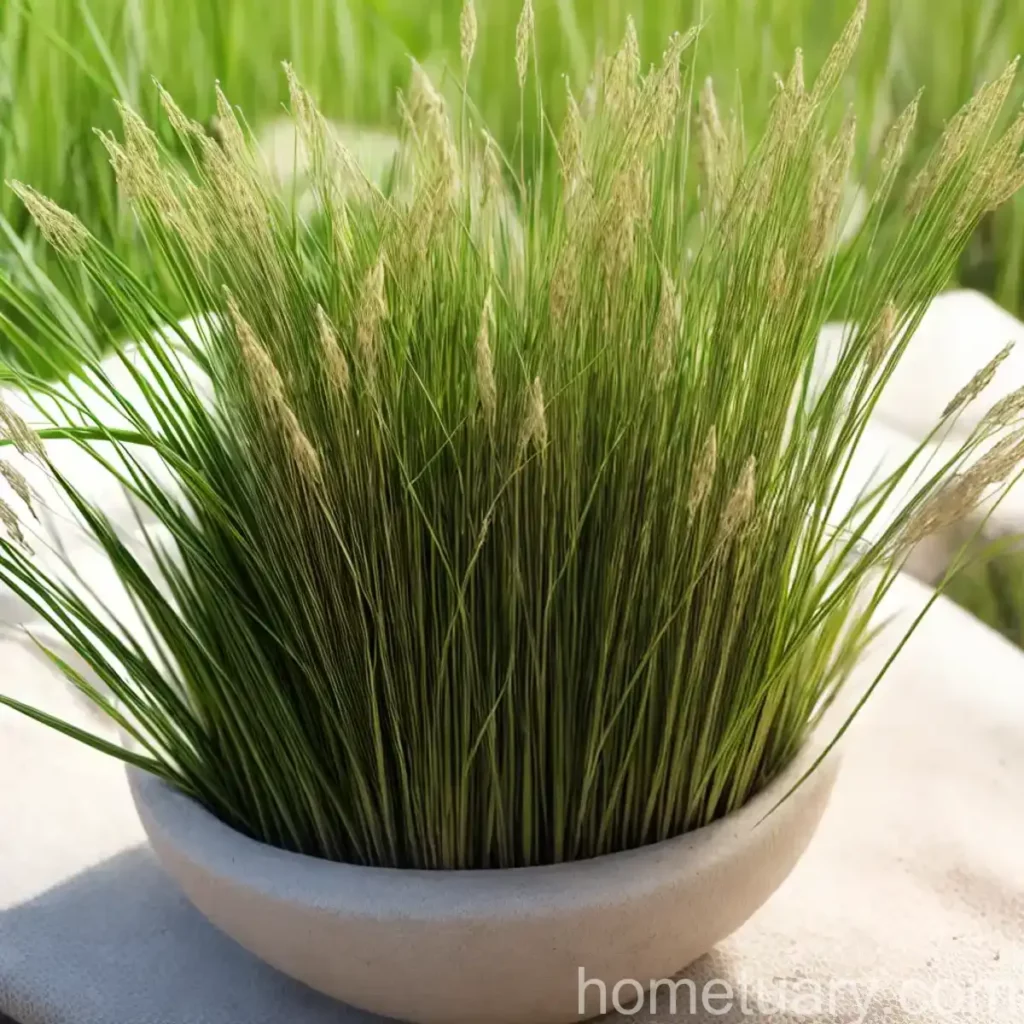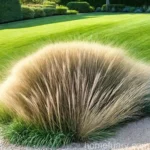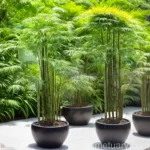Plant Scientist’s Guide to Finestem Needlegrass (Nassella tenuissima)
As a plant scientist with a passion for exploring the diverse world of plants, I find the finestem needlegrass (Nassella tenuissima) to be a fascinating and versatile plant species to study and grow. In this comprehensive guide, we will delve into the various aspects of the finestem needlegrass, including its culture, uses, maintenance, propagation, common pests, diseases, and a plethora of other valuable information for plant enthusiasts and horticulturists.
What is Finestem Needlegrass (Nassella tenuissima)?
Finestem needlegrass, scientifically known as Nassella tenuissima, is a perennial grass species native to North America. It is recognized for its finely textured, emerald-green foliage and delicate, feathery inflorescences, making it a sought-after ornamental grass in landscaping and gardening. This species belongs to the Poaceae family and is valued for its adaptability to various environmental conditions, including its exceptional drought tolerance, which makes it a suitable choice for xeriscaping and water-conserving landscapes.
Key Takeaways
Before exploring the finer details of finestem needlegrass, let’s summarise the key takeaways about Nassella tenuissima:
- Botanical Name: Nassella tenuissima
- Common Name: Finestem Needlegrass
- Plant Type: Perennial ornamental grass
- Watering: Drought-tolerant, prefers well-drained soil
- Sunlight: Thrives in full sun to partial shade
- Soil: Adaptable, but prefers sandy or loamy soil types
- Propagation: Can be propagated from seeds or division
- Common Uses: Landscaping, erosion control, groundcover, wildlife gardens
- Maintenance: Low-maintenance once established
- Pest and Diseases: Relatively pest and disease resistant
Now that we have an overview of finestem needlegrass, let’s delve deeper into its culture, uses, and maintenance requirements to understand how to best care for this elegant grass species.
Culture
Cultivating finestem needlegrass requires an understanding of its specific cultural requirements to ensure optimal growth and performance. From its water and sunlight needs to soil preferences and pruning techniques, here’s a detailed look at the cultural aspects of Nassella tenuissima.
Water
Finestem needlegrass is renowned for its remarkable drought tolerance, making it an excellent choice for water-conserving landscapes and regions with arid climates. While it can thrive in dry conditions, especially once established, providing occasional deep watering during prolonged periods of drought can help maintain its overall health and vigor. However, it is crucial to avoid overwatering, as Nassella tenuissima is susceptible to root rot in waterlogged soil.
Watering Guidelines:
– Established Plants: Water deeply but infrequently, allowing the soil to dry between waterings.
– Newly Planted: Ensure regular watering until the plant becomes established, then gradually transition to less frequent watering.
Sunlight
In its natural habitat and cultivated environments, finestem needlegrass exhibits a preference for full sun to partial shade. Adequate sunlight is essential for promoting vigorous growth, enhancing the visual appeal of its foliage, and encouraging the development of its characteristic feathery inflorescences. When planted in shadier locations, the grass may become leggy and less robust, so providing ample sunlight is recommended for optimal performance.
Sunlight Requirements:
– Full Sun: Ideally, provide at least 6-8 hours of direct sunlight daily for best results.
– Partial Shade: Tolerates partial shade, but may exhibit reduced growth and vigor compared to plants in full sun.
Soil
Nassella tenuissima is relatively adaptable to a range of soil types, including sandy, loamy, or rocky soils, as long as they are well-drained. It is crucial to avoid waterlogged or compacted soil, as this can lead to root suffocation and adversely impact the plant’s health. In regions with heavy clay soils, amending the soil with organic matter, such as compost or peat moss, can improve drainage and create a more hospitable growing environment for finestem needlegrass.
Soil Requirements:
– Drainage: Excellent drainage is essential to prevent waterlogging and root problems.
– pH: Tolerant of a wide pH range, but slightly acidic to slightly alkaline soil is ideal.
– Amendments: Incorporating organic matter can enhance soil structure and fertility.
Fertilizer
In general, finestem needlegrass is not particularly demanding in terms of fertilizer requirements. However, providing a balanced and moderate application of a low-nitrogen fertilizer in early spring can support healthy growth and a vibrant green coloration of the foliage. Overfertilization should be avoided, as it can lead to excessive vegetative growth at the expense of the plant’s natural form and visual appeal.
Fertilizing Tips:
– Timing: Apply fertilizer in early spring, before the onset of active growth.
– Type: Choose a balanced, slow-release fertilizer with a lower nitrogen content.
– Moderation: Use fertilizer sparingly to prevent excessive foliage growth.
Pruning
Pruning finestem needlegrass is generally minimal, as the plant maintains an attractive form and size without extensive pruning requirements. However, removing any damaged or discolored foliage, as well as trimming back the old inflorescences in late winter or early spring before new growth emerges, can help rejuvenate the plant and maintain its aesthetic appeal. Additionally, periodic removal of any invasive or unwanted growth can help preserve the plant’s desired shape and prevent overcrowding.
Pruning Guidelines:
– Annual Cleanup: Trim back old foliage and inflorescences in late winter or early spring.
– Selective Pruning: Remove any dead or damaged foliage as needed to maintain plant health.
– Shape Maintenance: Trim invasive growth to preserve the plant’s desired form.
Propagation
Understanding the methods of propagating finestem needlegrass is valuable for expanding its presence in gardens, landscapes, and restoration projects. Whether through seed propagation or division, the following propagation techniques offer opportunities to propagate Nassella tenuissima and introduce it to new environments.
Seed Propagation
Propagating finestem needlegrass from seeds is a viable and straightforward method to expand its presence in various settings. Harvesting mature seeds from the plant’s inflorescences allows for the collection of viable seeds for sowing in suitable growing conditions. The following steps outline the basic process of seed propagation for Nassella tenuissima:
Seed Propagation Steps:
1. Seed Collection: Harvest the mature seeds from the plant’s inflorescences in late summer to early fall.
2. Seed Preparation: Remove any debris and ensure the seeds are fully dried before storage or sowing.
3. Sowing: Place the prepared seeds in well-draining seed-starting mix or sandy soil, and lightly cover the seeds with a thin layer of soil.
4. Moisture and Temperature: Keep the soil moist but not waterlogged, and provide warmth and adequate light for germination.
5. Transplanting: Once the seedlings have developed several sets of true leaves, they can be transplanted into individual containers or directly into prepared garden beds.
Division
Dividing established clumps of finestem needlegrass is an effective method to propagate the plant and create new plantings from existing specimens. This technique can rejuvenate older plantings, control the size and spread of the grass, and produce additional plants for use in different areas of the landscape.
Division Guidelines:
– Timing: Divide the clumps in early spring before the onset of active growth or in early fall.
– Clump Selection: Choose healthy, well-established clumps for division, ensuring each division has an adequate root system.
– Planting: Replant the divisions at the same depth as the original plant, and water thoroughly after planting to promote establishment.
Uses
The ornamental and practical uses of finestem needlegrass make it a valuable addition to various landscapes and garden settings. From erosion control and groundcover applications to its role in wildlife gardens and mixed borders, Nassella tenuissima offers versatility and visual appeal in a range of environments.
Landscaping
In landscaping, finestem needlegrass serves as an attractive and functional element, contributing to the aesthetic appeal and ecological balance of outdoor spaces. Its fine-textured foliage, graceful form, and delicate inflorescences make it an ideal choice for incorporating texture, movement, and visual interest in landscape designs. Whether used as a focal point, mass planting, or as part of mixed plantings with other ornamental grasses and perennials, Nassella tenuissima adds depth and character to diverse landscapes.
Landscaping Ideas:
– Accent Planting: Highlight the grass’s airy texture and form in key areas of the landscape for visual impact.
– Mixed Borders: Combine finestem needlegrass with flowering perennials and shrubs for dynamic and layered borders.
– Naturalistic Settings: Integrate Nassella tenuissima in meadow-like or prairie-style landscape designs for a naturalistic appeal.
Erosion Control
Due to its fibrous root system and adaptability to various soil types, finestem needlegrass is an effective option for erosion control on slopes, embankments, and other vulnerable areas. The grass’s ability to bind soil particles and reduce erosion, particularly in regions prone to soil movement and degradation, makes it a valuable asset in conservation and land management initiatives.
Erosion Control Benefits:
– Soil Stabilization: Establishes a network of roots that anchor the soil and mitigate erosion.
– Slope Plantings: Utilize Nassella tenuissima to stabilize slopes and prevent soil runoff.
– Conservation Projects: Contribute to conservation efforts by incorporating finestem needlegrass in erosion-prone areas.
Groundcover
Creating a low-maintenance and visually appealing groundcover with Nassella tenuissima offers numerous benefits for gardeners and landscapers. Whether used in expansive areas or to fill in gaps between other plants, the grass’s spreading habit and attractive foliage provide a sustainable and attractive groundcover solution.
Groundcover Applications:
– Weed Suppression: Forms a dense mat that inhibits weed growth and reduces the need for herbicidal treatments.
– Visual Cohesion: Unifies planting areas with a carpet of fine-textured foliage, creating a cohesive and polished look.
– Low Maintenance: Requires minimal care once established, making it an efficient and sustainable groundcover option.
Wildlife Gardens
Finestem needlegrass plays a vital role in promoting biodiversity and supporting wildlife in garden settings. Its dense foliage and seed heads offer shelter, nesting materials, and food sources for various species of birds, insects, and small mammals, making it an essential component of wildlife-friendly landscapes.
Wildlife Benefits:
– Bird Habitat: Attracts and sustains bird species that utilize grassy cover for nesting and foraging.
– Butterfly Host Plant: Provides a suitable host plant for butterfly larvae, contributing to pollinator diversity.
– Insect Shelter: Offers protective cover for beneficial insects and other invertebrates essential for ecosystem health.
Popularity
The widespread popularity of finestem needlegrass stems from its exceptional adaptability, aesthetic appeal, and practical benefits in diverse settings. From residential gardens and public parks to commercial landscapes and restoration projects, Nassella tenuissima’s popularity continues to grow due to its distinct characteristics and versatile applications.
Residential Gardens
In residential gardens and home landscapes, finestem needlegrass serves as a go-to choice for homeowners seeking to incorporate texture, movement, and year-round interest in their outdoor spaces. Whether used as a standalone specimen, part of mixed perennial borders, or as a low-maintenance groundcover, Nassella tenuissima blends seamlessly with various garden styles and complements a wide range of companion plants.
Home Garden Features:
– Low Water Needs: Appeals to homeowners looking for water-wise and sustainable landscaping solutions.
– Architectural Interest: Adds structural elegance and visual appeal to garden beds and borders.
– Wildlife Attraction: Encourages biodiversity and ecological balance in home garden environments.
Public Landscapes
In public parks, botanical gardens, and municipal landscapes, Nassella tenuissima enhances the visual impact and ecological functionality of outdoor environments. Its adaptability, low-maintenance nature, and ability to thrive in urban conditions make it an asset for public landscapes seeking resilient and visually compelling vegetation.
Public Landscape Applications:
– Urban Green Spaces: Introduces greenery and texture to urban parks and streetscapes, even in challenging environments.
– Conservation Areas: Contributes to native plantings and restoration efforts in public conservation areas.
– Educational Gardens: Showcases the ecological and practical merits of finestem needlegrass to the public.
Commercial Landscapes
From commercial developments and corporate campuses to hospitality venues and retail landscapes, Nassella tenuissima’s aesthetic and functional benefits make it an appealing choice for commercial landscape designs. Its adaptability to diverse growing conditions and ability to withstand foot traffic in some instances make it suitable for various commercial settings.
Commercial Applications:
– Business Districts: Contributes to urban streetscapes and green infrastructure in commercial districts.
– Outdoor Seating Areas: Softens hardscapes and adds naturalistic appeal to outdoor gathering spaces.
– Branding and Image: Reflects a commitment to sustainable and visually appealing landscaping in commercial properties.
Restoration Projects
In ecological restoration and habitat enhancement projects, including prairie restorations, wetland mitigation, and reforestation efforts, the inclusion of finestem needlegrass is integral to supporting native biodiversity and stabilizing disturbed landscapes. Its adaptability to restoration sites and ability to thrive in challenging conditions make it an invaluable component of ecological restoration initiatives.
Restoration Benefits:
– Soil Stabilization: Assists in stabilizing soil and preventing erosion in restoration areas.
– Native Plantings: Contributes to the establishment of diverse native plant communities in restored habitats.
– Habitat Enhancement: Supports the reestablishment of wildlife habitat and ecological processes in degraded landscapes.
Common Diseases
While finestem needlegrass is generally robust and resilient, it can be susceptible to certain diseases and stressors that may affect its overall health and appearance. Recognizing and addressing common diseases and potential issues is essential for maintaining the vigor and vitality of Nassella tenuissima in various growing environments.
Disease Diagnosis
Understanding the symptoms and causes of common diseases affecting finestem needlegrass is crucial for effective disease management and plant care. The following are some common diseases and potential issues that may impact Nassella tenuissima:
Common Diseases and Issues:
– Leaf Spot: Characterized by the development of small, discolored spots on the foliage, often caused by fungal pathogens under humid conditions.
– Root Rot: Resulting from overly wet or waterlogged soil, leading to root suffocation and decline in plant health.
– Powdery Mildew: Manifests as a powdery white coating on the foliage, favored by warm, humid conditions and poor air circulation.
– Stress-related Issues: Including wilting, discoloration, and reduced growth due to drought, overwatering, or nutrient imbalances.
Disease Control
Implementing proactive measures and cultural practices can help mitigate the risk of diseases and promote the overall health and resilience of Nassella tenuissima. Proper cultural care, monitoring for early signs of diseases, and maintaining optimal growing conditions are key components of disease control in finestem needlegrass.
Disease Control Strategies:
– Water Management: Avoid overwatering and ensure soil drainage to prevent root-related issues.
– Air Circulation: Encourage good air movement around the plants to reduce humidity and minimize disease pressure.
– Sanitation: Remove and dispose of any affected plant parts to prevent the spread of fungal and bacterial pathogens.
– Maintain Plant Health: Proper watering, adequate sunlight, and balanced nutrition contribute to overall plant health and disease resistance.
Common Pests
While finestem needlegrass is relatively resistant to pest infestations, it may occasionally encounter certain insect pests that can impact its growth and vigor. Identifying potential pests and implementing appropriate pest control measures are essential for safeguarding Nassella tenuissima from pest-related issues.
Pest Identification
Being aware of the common pests that may affect finestem needlegrass enables early detection and intervention to prevent widespread infestations and damage to the plants. The following are some potential pests that may be encountered in Nassella tenuissima:
Potential Pests:
– Aphids: Small, sap-sucking insects that can distort foliage and excrete honeydew, leading to secondary fungal issues.
– Spider Mites: Tiny arachnids that feed on plant sap, causing stippling and discoloration on the foliage under hot and dry conditions.
– Grasshoppers: Large, chewing insects that may consume foliage and cause physical damage to the plants, particularly in open landscapes.
Pest Management
Implementing proactive pest management strategies and integrated pest management (IPM) practices can help prevent and address potential pest issues in finestem needlegrass. Cultivating pest-resistant varieties, monitoring for early signs of infestations, and employing targeted control measures are effective approaches to pest management.
Pest Management Strategies:
– Cultural Practices: Encourage natural predators, such as ladybugs and lacewings, that feed on aphids and mites.
– Horticultural Oils: Use horticultural oils to suffocate and control soft-bodied pests like aphids and spider mites.
– Physical Exclusion: Protect young plants from grasshopper damage using physical barriers and deterrents.
Botanist’s Tips
Drawing from botanical expertise and practical insights, the following tips and recommendations provide valuable guidance for successfully cultivating and caring for finestem needlegrass in various garden and landscape settings.
Maintenance Advice
Maintaining the health and vitality of Nassella tenuissima involves performing routine maintenance tasks and providing the necessary care to support its growth and visual appeal. The following tips outline essential maintenance practices for finestem needlegrass:
Maintenance Tips:
– Monitor Watering: Strike a balance between drought tolerance and periodic deep watering to sustain plant health.
– Soil Care: Prioritize well-drained soil, and avoid over-amending with rich, organic matter to prevent excessive vigor.
– Seasonal Review: Assess the condition of the plants seasonally and adjust care practices based on their performance.
– Observational Skills: Regularly observe plant health, growth patterns, and potential stressors to address issues promptly.
Environment Considerations
Understanding the distinct environmental considerations and site-specific factors that influence finestem needlegrass’s performance is essential for successful cultivation and long-term success. Tailoring care practices and design considerations to the local environment optimizes the plant’s resilience and visual impact.
Environmental Considerations:
– Microclimates: Identify microclimates within the landscape to accommodate the plant’s specific sunlight and moisture needs.
– Ecological Context: Consider the plant’s role in supporting local wildlife and ecological processes by selecting appropriate planting locations.
– Adaptive Planting: Utilize finestem needlegrass in areas with challenging growing conditions to harness its adaptability and resilience.
Aesthetic Integration
Integrating finestem needlegrass into garden design and landscape compositions involves thoughtful consideration of its aesthetic attributes and potential interactions with companion plants. From creating focal points to establishing















